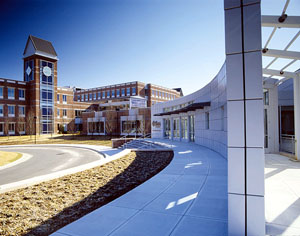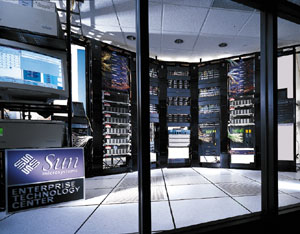Design Case Study: Sun Microsystems Builds Network Lab Center
By: James Dorsett, RCDD, strategic business planning manager Chatsworth Products
The Sun Microsystems (Palo Alto, CA) Enterprise Technology Center, located near Boston, forms the physical center of the 5,000 square foot laboratory that occupies floor space in one of Sun's large corporate campuses. The lab contains a staggering amount of equipment and includes, in addition to the banks of servers, 29 carrier-class switches. These are all visible from an enormous glass viewing area.

"The room is both a showcase and a selling tool," says Robert Saitow, the man who designed it, and who is currently technical support manager for the facility. "We put it right outside the main customer reception area for a very good reason. "We wanted to make an impression."
The Enterprise Technology Center certainly does that. The hundreds of separate port connections completely fill the nine floor-to-ceiling Chatsworth Products Inc. (CPI) rack systems.
Built as a showplace
"We built the facility for a number of reasons," relates Saitow. "We certainly wanted to showcase our capabilities but we also wanted to illustrate Sun's philosophy that 'The network is the computer.' But it's also an adjunct to the lab, and mostly what we're doing with the center is running simulations, emulating what would happen in a real working enterprise network.
"We don't like to refer to it as a data center, because it really isn't. It's a test site. Though, by design, it looks like a data center," he adds.
Rotation of equipment
The basic requirements of the center design were that all equipment be fully accessible to technicians and engineers at all times; that the cabling architecture support extremely flexible placement of equipment within the physical workspace; and, finally, that equipment be capable of being installed and removed at a moment's notice. "Most of the equipment in the room is swapped out within ninety days," explains Saitow. "That makes for an unusually dynamic environment."
What is permanent in the room are the CPI racks systems that are fixed and practically fill the room to capacity. The wiring runs are designed to provide the network capacity and cross-connection capabilities for any conceivable configuration of equipment in the near term. The switches themselves, which form the hub that directs traffic through the network, comprise the other element of underlying physical layer.
In order to contain all of the hardware while still making it accessible, Sun arranged the CPI rack systems in a "V" configuration. The towering rack systems along the front wall where, by design, all of the switches were placed, makes a compelling visual statement, leaving the interior of the room largely free for technicians to move about.
A rack system strategy
The CPI rack systems themselves were a key element in the overall design strategy. CPI offers a systems approach to network design. The company were chosen because its systems are fully modular, reinforced to bear the weight of the heaviest enterprise class components, equipped with sliding shelves for easy accessibility, offer comprehensive accessory routing hardware and provide for stringent cable management.
CPI rack systems permit cable runs along all exposed surfaces. All these provisions have proven vitally important to a facility that houses literally hundreds of pieces of equipment per year and must change connections on an almost daily basis.
The cable management options offered by CPI proved particularly valuable. Currently the center is wired for a total of 1,088 Ethernet 10/100 BaseT connections, and 768 multimode fiber connections. With literally tens of thousands of feet of cabling occupying a small space, advanced cable management became an absolute imperative, especially if an acceptable appearance is to be maintained.

Recalls Saitow, "planning the center took several months but performing the installation took a mere three weeks." The long gestation period evidently paid off because the installation process was not only rapid but was entirely free from difficulties.
Saitow stated, "It's one of the most interesting jobs we've ever done and, frankly, I'd like to do another one like it. "The visually arresting and supremely functional rack system has allowed the Sun team to move equipment in and out routinely proving the success of the original plan in this dynamic environment."
About the author:
James Dorsett, Registered Communications System Designer (RCDD), is the strategic business-planning manager at Chatsworth Products Inc. (Westlake Village, CA) For more information contact CPI's customer service at 818-882-8595 or 252-514-2779, or by email at info@chatsworth.com or visit <%=company%>.
